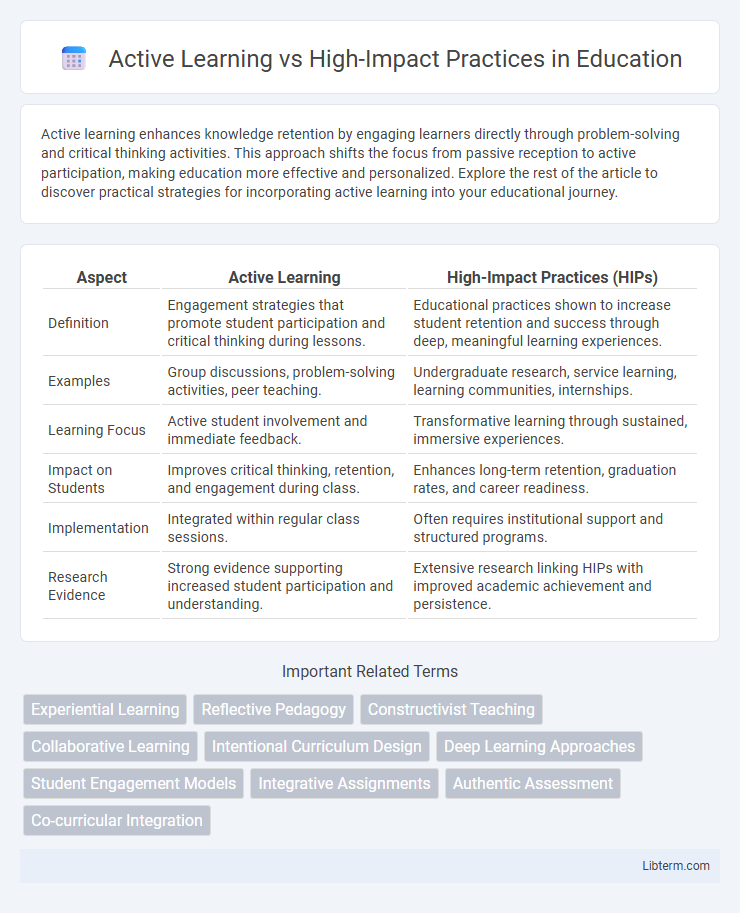Active learning enhances knowledge retention by engaging learners directly through problem-solving and critical thinking activities. This approach shifts the focus from passive reception to active participation, making education more effective and personalized. Explore the rest of the article to discover practical strategies for incorporating active learning into your educational journey.
Table of Comparison
| Aspect | Active Learning | High-Impact Practices (HIPs) |
|---|---|---|
| Definition | Engagement strategies that promote student participation and critical thinking during lessons. | Educational practices shown to increase student retention and success through deep, meaningful learning experiences. |
| Examples | Group discussions, problem-solving activities, peer teaching. | Undergraduate research, service learning, learning communities, internships. |
| Learning Focus | Active student involvement and immediate feedback. | Transformative learning through sustained, immersive experiences. |
| Impact on Students | Improves critical thinking, retention, and engagement during class. | Enhances long-term retention, graduation rates, and career readiness. |
| Implementation | Integrated within regular class sessions. | Often requires institutional support and structured programs. |
| Research Evidence | Strong evidence supporting increased student participation and understanding. | Extensive research linking HIPs with improved academic achievement and persistence. |
Understanding Active Learning: Definition and Key Elements
Active learning is a student-centered approach that emphasizes engagement through interactive techniques such as discussions, problem-solving, and collaborative projects. Key elements include continuous feedback, critical thinking, and the application of knowledge in real-world contexts, fostering deeper comprehension and retention. Unlike high-impact practices, active learning can be integrated across various course formats and disciplines to enhance overall academic performance.
High-Impact Practices: Core Concepts and Examples
High-Impact Practices (HIPs) are educational activities demonstrated to significantly enhance student engagement and learning outcomes through sustained interaction, real-world application, and collaborative experiences. Core concepts include diversity of learning experiences, frequent feedback, and opportunities for reflection, which foster deep understanding and personal development. Examples of HIPs encompass service-learning, undergraduate research, learning communities, internships, and capstone projects, all designed to challenge students and promote academic and professional growth.
Comparing Objectives: Active Learning vs High-Impact Practices
Active Learning aims to engage students directly in the learning process through interactive techniques like discussions, problem-solving, and hands-on activities, enhancing comprehension and critical thinking skills. High-Impact Practices (HIPs) focus on transformational experiences such as service learning, undergraduate research, and learning communities to promote deep learning, persistence, and student engagement. While both approaches seek to improve educational outcomes, Active Learning emphasizes moment-to-moment engagement, whereas HIPs prioritize sustained, meaningful student involvement over longer periods.
Engagement Strategies: How Students Benefit
Active learning employs techniques like group discussions, problem-solving tasks, and case studies to increase student participation and critical thinking. High-impact practices such as service learning, undergraduate research, and learning communities foster deeper engagement by connecting academic work with real-world experiences. These engagement strategies enhance student retention, improve critical thinking skills, and promote a sense of belonging and motivation throughout the educational journey.
Classroom Implementation: Methods and Approaches
Active learning in classroom implementation involves interactive methods such as think-pair-share, problem-based learning, and peer instruction, which encourage student engagement and critical thinking. High-impact practices focus on integrative approaches like collaborative projects, service learning, and undergraduate research that promote deep learning and long-term retention. Both strategies prioritize student-centered pedagogy, but active learning emphasizes real-time participation while high-impact practices often extend learning beyond traditional class boundaries.
Evidence of Effectiveness: Research and Outcomes
Active learning strategies have consistently demonstrated improved student engagement and higher retention rates through empirical studies highlighting increased critical thinking and problem-solving skills. High-Impact Practices (HIPs), such as service learning and undergraduate research, show strong correlations with positive academic outcomes, including higher graduation rates and deeper learning, supported by longitudinal data from the Association of American Colleges & Universities. Meta-analyses confirm that integrating active learning within HIPs amplifies educational benefits by fostering collaborative and experiential learning environments.
Challenges and Limitations: Barriers to Success
Active learning faces challenges such as uneven student participation, increased class preparation time, and resistance from both students and instructors accustomed to traditional lectures. High-impact practices encounter limitations including resource constraints, scalability issues, and varying institutional support that hinder consistent implementation across diverse educational settings. Both approaches require significant institutional commitment and faculty training to overcome barriers and achieve successful student engagement and learning outcomes.
Integrating Active Learning with High-Impact Practices
Integrating active learning with high-impact practices enhances student engagement by promoting critical thinking, collaboration, and real-world application of knowledge. Techniques such as collaborative projects, undergraduate research, and service learning create immersive experiences that deepen understanding and retention. This integration fosters inclusive learning environments and improves academic outcomes by aligning interactive pedagogy with proven educational strategies.
Case Studies: Success Stories in Education
Case studies showcasing Active Learning demonstrate improved student engagement and retention rates, with institutions reporting a 20-30% increase in academic performance through hands-on, experiential methods. High-Impact Practices (HIPs), such as collaborative projects and undergraduate research, have been linked to higher graduation rates and enhanced critical thinking skills, with studies indicating a 15% boost in college completion. Educational success stories reveal that integrating Active Learning with HIPs fosters deeper understanding and long-term knowledge retention, creating more effective and inclusive learning environments.
Future Directions: Innovations and Emerging Trends
Future directions in active learning and high-impact practices emphasize the integration of adaptive technologies and data analytics to personalize educational experiences and enhance student engagement. Emerging trends include the use of virtual and augmented reality to create immersive, experiential learning environments that complement traditional high-impact practices like service learning and collaborative projects. Innovations in real-time feedback systems and AI-driven content delivery are expected to further optimize learning outcomes and scalability across diverse academic disciplines.
Active Learning Infographic

 libterm.com
libterm.com